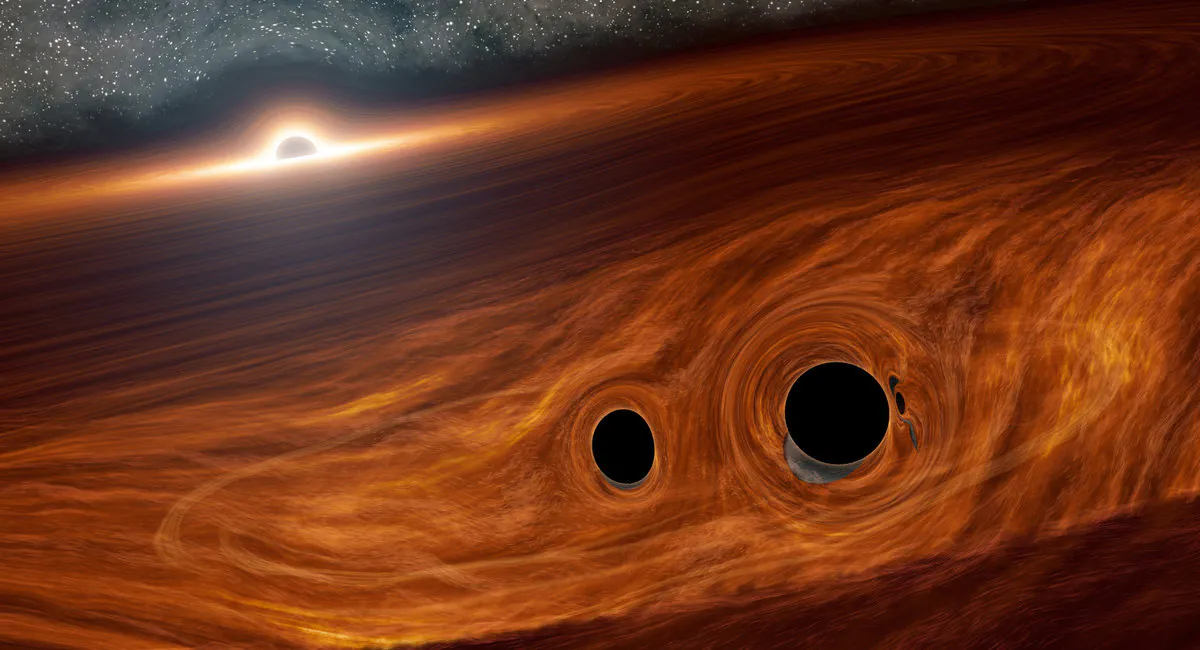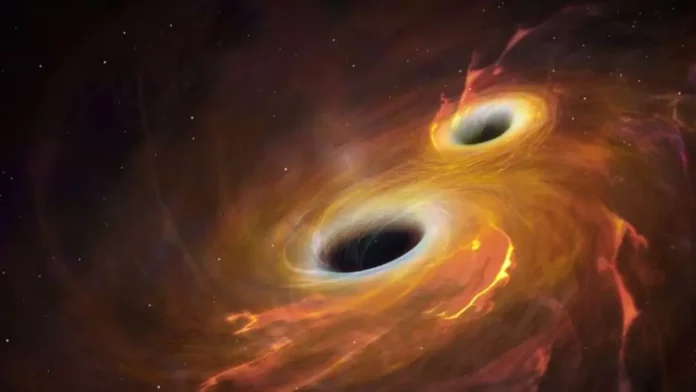© ROOT-NATION.com - Use of content is permitted with a backlink.
Using archival data from the Gemini North telescope, astronomers have measured the heaviest pair of supermassive black holes ever found. The merger of two supermassive black holes is a phenomenon that has long been predicted, but never observed. This massive pair provides clues as to why such an event seems unlikely in the universe.
Almost every massive galaxy contains a supermassive black hole at its centre. When two galaxies merge, their black holes can form a binary pair, that is, be in a bound orbit with each other. It is hypothesized that these binary pairs are destined to merge over time, but this has never been observed. Whether such an event is possible has been a topic of debate among astronomers for decades.
Astronomers used data from the Gemini North telescope in Hawaii, which is one-half of the Gemini International Observatory operated by the National Institute of Physics’ NOIRLab, to analyse the supermassive binary black hole located in the elliptical galaxy B2 0402+379. It is the only supermassive binary black hole that has been seen in enough detail to see both objects separately, and it holds the record for the shortest distance that has been measured directly, just 24 light years. While such a close distance augurs well for a powerful merger, further investigation revealed that the pair has been stuck at this distance for over three billion years, which begs the question: What is the reason for the delay?

To better understand the dynamics of this system and its stalled merger, the team turned to archival data from the Gemini North Multi-Object Spectrograph (GMOS), which allowed them to determine the velocities of stars in the vicinity of black holes.
“The remarkable sensitivity of GMOS allowed us to map the increase in the speed of stars as they approach the centre of the galaxy,” said Roger Romani, a professor of physics at Stanford University and a co-author of the paper. “Thanks to this, we were able to conclude the total mass of black holes that are there.”
The team estimates that the mass of the binary black hole is 28 billion times that of the Sun, making the pair the heaviest binary black hole ever measured. This measurement not only provides valuable context for the formation of the binary system and the history of its host galaxy, but also confirms the long-held theory that the mass of a supermassive binary black hole plays a key role in holding back a potential merger.
“The Gemini International Observatory data archive contains a gold mine of untapped scientific discoveries,” said Martin Still, NSF program director for the Gemini International Observatory. “Measuring the mass of this supermassive binary black hole is a striking example of the potential impact of new research examining this rich archive.”
Understanding how this binary formed can help predict if and when it will merge—several clues indicate that the pair formed from the merger of multiple galaxies. First, B2 0402+379 is a “fossil cluster”, that is, the result of the merger of stars and gas of an entire cluster of galaxies into one massive galaxy. In addition, the presence of two supermassive black holes, combined with their large combined mass, suggests that they formed from the merger of several smaller black holes from different galaxies.
After a galactic merger, supermassive black holes do not collide head-on. Instead, they begin to fly past each other, settling into a limited orbit. With each pass, energy is transferred from the black holes to the surrounding stars. Losing energy, the pair is drawn closer and closer until they are light years apart, where gravitational radiation takes over and they merge. This process has been directly observed in pairs of stellar-mass black holes – the first case was recorded in 2015 thanks to the detection of gravitational waves – but has never been observed in binary supermassive systems.
With new knowledge of the system’s extremely large mass, the team concluded that it would take an extremely large number of stars to slow the binary system’s orbit enough to bring them closer together. In the process, black holes appear to have ejected almost all the surrounding matter, leaving the galactic core devoid of stars and gas. With no more material to further decelerate the pair’s orbit, their merger stalled in its final stages.

“Galaxies with lighter black hole pairs usually seem to have enough stars and mass to get close quickly,” says Romani. “Because this pair is so heavy, it needs a lot of stars and gas to get the job done. But the binary cleared the central galaxy of such matter, leaving it frozen and available for our study.”
Whether they will overcome stagnation and eventually merge in millions of years, or remain in orbital limbo forever, remains to be seen. If they merge, the resulting gravitational waves will be 100 million times more powerful than those produced by merging stellar-mass black holes.
It’s possible that the pair could overcome this final distance through another galactic merger, which would breathe additional material into the system, or perhaps a third black hole, to slow the pair’s orbit enough for it to merge. However, given B2 0402+379’s status as a fossil cluster, a new galaxy merger is unlikely.
“We’re looking forward to further studies of the core of B2 0402+379, where we’ll see how much gas it contains,” said Tirth Surti, a Stanford graduate student and lead author of the paper. “This will give us more insight into whether supermassive black holes can merge over time, or whether they will remain as a binary system.”
Read also:
- SLIM sent valuable data on ten moon rocks to Earth
- NASA has completed the preparation of the VIPER robotic lunar rover


